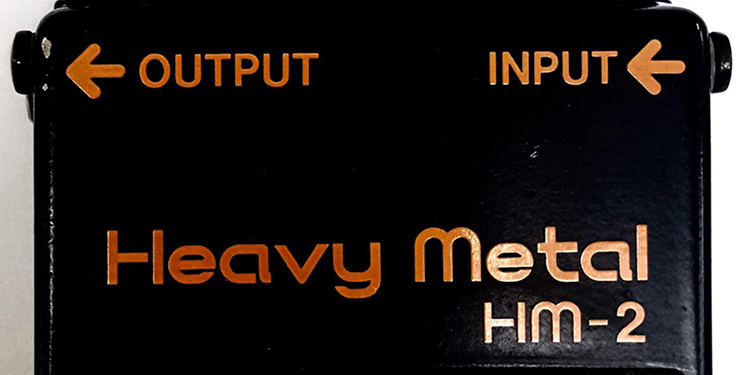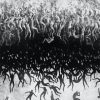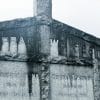Buzzsaw. It’s doubtful there’s ever been a single word more on-the-nose for describing a guitar’s tone. It metaphorically captures the violent brutality of the music associated with it, but at the same time literally describes the timbre and pitch of the tone. And though the word goes hand-in-hand with Swedish death metal and the multitude of acts that movement influenced, it can be traced to one particular piece of musical gear: the BOSS HM-2 (the H and M stand, of course, for “Heavy Metal”). This little black pedal with it’s Halloween-orange knobs is so ubiquitous that its name has basically become a genre in and of itself: if you google “HM-2” you find everything from reviews of Swedeath albums using it as a signifier (“HM-2 goodness”) to people on forums asking for “HM-2 recommendations” (I even stumbled on someone referring to “HM2core”).

Photo Credit: Steve Hinksman
What’s kind of funny is that BOSS only made the pedal for nine years (in Japan from 1983-88 and then in Taiwan for another three years) and discontinued it only a year after the release of the album that went on to spawn decades of bands chasing its unique sound (Entombed’s Left Hand Path). Oddly enough, during the actual 80’s run of the pedal, the most notable guitarist to champion it was David Gilmour of Pink Floyd. But it was the intense un-nuanced guitar sound on Left Hand Path that started the HM-2’s notoriety. When Tomas Skogsberg, Entombed’s producer, began using the pedal as a stand-by in his Sunlight Studios in Stockholm a movement was born. Swedish Death Metal had a signature tone.
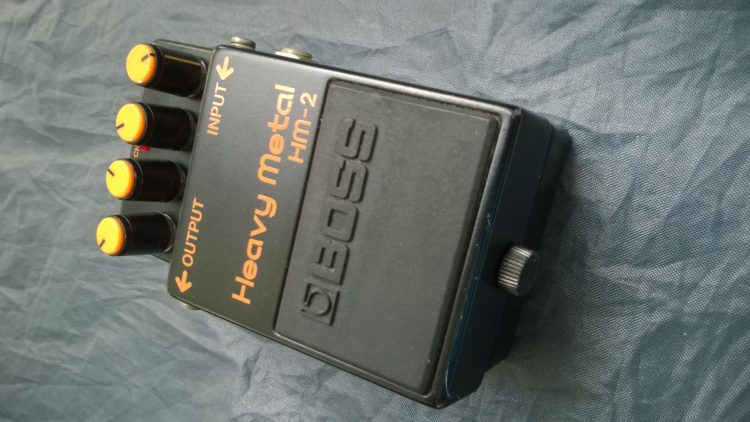
Credit: user “sentenced” from The Gear Page
Flash forward 25 years, and today’s metal landscape has splintered into more sub-genres than one could count with all their fingers and toes. But the buzzsaw sound hasn’t gone away. In fact, Swedeath is now a “classic” sub-genre, and every year there are bands that tickle our nostalgia by avoiding new trends and laying down no-nonsense albums harkening back to the Sunlight Studios heyday. For many of these bands (and certainly many bands that defy the Swedeath tag as well) that HM-2 sound is a key color in their crusted palette. However, in many cases, what you’re actually hearing today isn’t a BOSS HM-2 at all: it’s a boutique clone, built not on an assembly line in Japan or Taiwan, but crafted by a lone builder. Even though used HM-2’s are readily available on the secondary market (prices seem to float around $120-150 depending on condition), players are willing to get on a wait list and pay over $200 for a modern pedal that takes the HM-2’s circuit as a jumping-off point. It might sound odd to pay twice as much for a clone of a pedal that’s relatively easy to find, but for a pedal that has developed such a cult following, the original has a number of inherent issues (including a lot of hiss and white noise which is a real headache for guitarists that rely on palm-muting and starts-and-stops).
We wanted to know more about this pedal that’s a core element of so many amazing records, especially since it’s known, even by those who use and love it, as a one-trick-pony (infamously, those Swedish bands cranked all the knobs to max, because the HM-2 is notorious for having basically a worthless range to the distortion control). What follows is an oral history of this iconic noisemaker, told by the people who’ve used it, reverse-engineered and cloned it, and even pioneered its role in death metal history. All interviews were conducted separately, and have since been edited together to provide a narrative flow.
Tomas Skogsberg [Sunlight Studios]: I discovered the HM-2 late 80’s. I always liked the midrange, it suited me perfectly.
Anders Nyström [Guitarist for Bloodbath]: My first acquaintance with this legendary guitar tone would be through Entombed’s Left Hand Path released 27 years ago. I remember we were surprised, or perhaps almost confused, by how Entombed’s sound felt so much more raw and brutal than, for instance, what the entire Florida scene had going on (in the Morrisound studio). We didn’t know the story behind the guitar sound back then, but we vividly discussed how the Sunlight Studio productions enhanced the sound to feel darker in general, almost “winterlike.”
Antti Boman [Guitarist/Vocalist for Demilich, Winterwolf]:I remember the high expectations of anything that was to come from Sunlight studios. We knew there was this guarantee of fabulous guitar sounds, which was, apart from other factors, due to this magical guitar pedal called the Boss HM-2.
Rogga Johansson [Guitarist for Paganizer]: I think it must have been Dismember, actually, the Pieces mini-album in 1992 when I was 15 years old. I actually remember thinking it must be the rawest most heavy stuff I’ve ever heard back then, and still today Pieces is my fave release from Dismember besides their later more catchy masterpiece “Massive killing capacity.”
Jay Jancetic [Guitarist for Harm’s Way/Atonement Theory]: I was always a fan of Entombed, of course, but it wasn’t really until I first heard “Wolverine Blues” that I really started to ponder their signature guitar tone. I’m not really sure why that’s the case. Maybe it’s because of the improved production on that record, or it was just what I was into at that time. The tone was still there, but it was a bit more refined and utilized in a way that was different than before. I guess that’s also why I chose to try and do something similar myself. Take something already great and improve on it. Make it my own.
Kurt Ballou [Guitarist of Converge, The Huguenots, Blue/Green Heart, and Kid Kilowatt; Recording engineer, producer, and owner of Godcity Recording Studio]: My fascination with the HM-2, like many people, began the first time I heard Entombed. I had no idea how they got that sound and this was back before the internet was chattering about such things, so I was just left scratching my head.
Anders Nyström: I can’t remember who revealed the big secret being the Boss HM-2, but the following year, I had a memorable incident while I was at the movies as suddenly a car-stereo commercial by Pioneer came on the cinema screen while blasting ‘Override Of The Overture’ by Dismember. Believe me, the impact was so brutal that I was fucking nailed to my seat! It really dawned on me right there, that has gotta be the ultimate death metal guitar tone! It literally sounded like someone was playing notes on an actual buzzsaw, delivering swedish death metal as we know it.
Antti Boman: I didn’t have the money for such a beast, or didn’t dare to incorporate in my shitty rig. And maybe that was something to be left for Swedes. Otherwise we would have stolen their invention, and we Finns didn’t want to use anything that was invented in Sweden. Apart from Nobel prize, of course. But oh, we loved the tone so very much!
Kurt Ballou: The first time I saw [Entombed], I noticed Uffe had a wah pedal on stage. Could it be a cocked wah effect? Tried it. Wasn’t it, but there was something to the extreme mid boost that seemed like I was on the right track. So I tried all sorts of other EQ schemes and never quite found the thing. Eventually I recorded Backstabbers Inc. and Brian, their guitar player at the time, who would go on to form Trap Them, told me about the HM-2. I knew the pedal, but I had never tried it with the EQ maxed. Eureka!
Nicholas Williams [Dunwich Amps – maker of many HM-2-based pedals]: From my perspective, the best rationale [for why the HM-2 works for death metal] is the shape of the EQ. The EQ forms a very strong set of peaks around 88Hz and 1kHz which creates an apparent low-mid notch around 200-300Hz. The combination of that EQ response with the general harsh nature of the clipping in the circuit creates a very raw sound that seems to be perfect for certain kinds of heavy music.
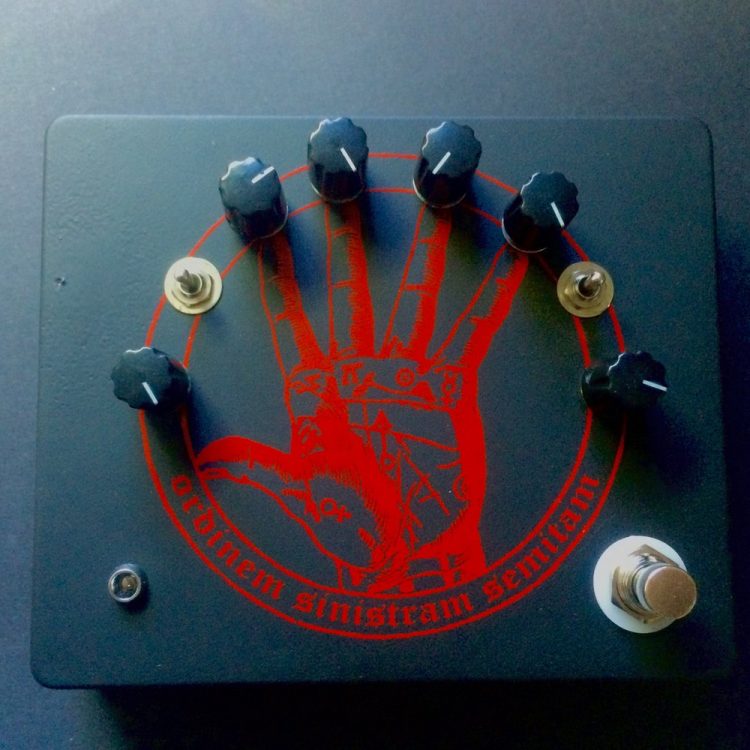
Modded HM2 — Credit: Dunwich Amps
Joe Anastasio [Lone Wolf Audio – maker of the Left Hand Wrath, an HM-2-based pedal]: It is technically a distorted graphic EQ. The EQ is what is called Gyrator based so you can boost/cut aspects of the EQ band and the values used in the HM-2 were originally chosen to sound like a Marshall amp by boss. Of course though, in the hands of Tomas at Sunlight [Studios], they found that by running the HM-2 before a [BOSS] DS-1 created the foundation for what we know today. In addition to this, When stacked into a gain channel, or run before a distortion pedal it sounds like a throttled chainsaw.

Left Hand Wrath — Credit: Lone Wolf Audio
Ola Lindgren [Vocalist/Guitarist for Grave]: We’ve never used the HM-2 on any Grave recordings or live. In fact I’ve never even owned one hehe. In the old days, we used the Boss DS1 pedal in a Fender Bassman head. Feel free to include that in the story so that the record can be set straight 🙂
Rogga Johansson: The tone hasn’t influenced me very much actually, contrary to what people might believe. I’ve never been a HM-2 sorta freak; even though I love the sound, I usually tend to take away some of the grainy dirt and add some more meat to it, probably because before getting into the Swedish sound more and more I grew up listening to thrash metal and industrial metal, and both those styles always had a more meaty tighter tone, which I also love.
Anders Nyström: I guess we formed Bloodbath partially because of [the buzzsaw tone], because both Entombed and Dismember, two of our biggest influences, set that tone as their trademark. I used to say with that tone you could just just strike a simple ”E chord” and that would be good enough to qualify as a good riff haha! In my opinion, the sound is so intense that just one tone ringing still keeps it interesting and entertaining and I can’t say that about anything else. It’s like hell in audio caused by possessed buzzsaws!
Antti Boman: Winterwolf was the band that made me acquire the pedal. It was, after all, a kind of Swedish DM rip-off, so it naturally required the HM-2 tone.
Kurt Ballou: Brian [from Backstabber’s Inc and Trap Them] and I have now made a ton of records together using HM-2’s and I’ve also recorded Disfear, Nails, Black Breath and others who use HM-2, so I’m pretty well versed in how to properly gain stage an amp to get that pedal sounding right, at least for the death n’ roll / stadium crust interpretations of that sound, which is what I prefer. The key to the pedal seems to be not in the distortion, but the EQ. It utilizes 3 band-pass filters which focus the lows, mids, and highs to 3 very distinct, somewhat narrow frequencies. The mids and highs are voiced very close together, and almost look like the same band on a spectrum analyzer. This is what gives it it’s nastiness, but it’s also what gives [it] its focus. With the EQ focused on a few specific frequencies, it opens up a lot of space in the mix for drums and bass to live. I think that’s why, as a recording engineer, I really love it.
Nicholas Williams: I have seen a variety of approaches to using the pedal but usually the sound of the pedal … combined with a distorted amp is the key to the HM-2 sound.
Joe Anastasio: [You] need to run it into the high-gain channel with the volume low and high knobs maxed. Max the gain too for added effect. I personally run any type of HM-2 circuit full bore into the gain channel of my Mesas or Peaveys. And Into my Ampeg V4 I run a specially tuned black mesa or FOAD pedal I make along with a Left Hand Wrath to simulate the amp having a gain channel as the v4 is a clean amp only.
Nicholas Williams: I am not sure there is something that is 100% unique to a HM-2 type pedal, but there are a few notable points about them. Even a stock HM-2 type design has a fairly large number of components compared to the average distortion pedal and that is even more so for the modded HM-2s. The EQ is also sensitive to the resistor and capacitor values used in the gyrator circuit. A few of the designs that I created included internal tuning controls to fine tune the EQ points to achieve an optimum sound. Small adjustments can lead to fairly dramatic changes in the overall sound especially if the EQ is cranked to 10.
Joe Anastasio: You have to know how to EQ your amp (too much presence is too bright – stop doing that all you 5150 users). I personally use Electro Voice speakers so my personal amp settings are going to be different from what someone else would be using. I mostly set the mid knob just below noon , either dime or almost dime the low and set the high at about 7-7.5 depending on the amp. Now granted, the best studio tone I’ve ever heard in person was a blue line Peavey Bandit combo with a Left Hand Wrath into the high gain channel , and the shift button off and the gain button on in the supersat section. This accentuates the nasally midrange so that when you slam the front end it sounds extra evil.
Tomas Skogsberg: It’s not just the pedal who makes the right sound. [It’s the] guitarist, desk, etc.
Rogga Johansson: At the rehearsal place I have the cheapest thing you can find really, a Behringer cab and a Kustom head. probably around 300 euros for both, but it works for me as I’ve always been able to get my own sound with some screwing around with any amp basically, with or without adding a pedal. I have a HM-2 pedal too, as well a sits clone from behringer HM300 as backup.
Patrick [Abominable Electronics – maker of the Throne Torcher pedal, an HM-2-based pedal]: A perfect rig for the Throne Torcher would be simply a vtm120 or another high gain Peavey head into two 4x12s (I have this rig and have played the Throne Torcher though it and it does sound amazing).

ThroneTorcher — Credit: Abominable Electronics
Nicholas Williams: I would probably build a tube amp that would be some kind of combination of a Marshall 2203 (JCM800) and an Ampeg V4b. Those kind of amp designs are great for layering the sound of the HM-2 over the amp distortion to create a really raw, heavy tone.
Joe Anastasio: I’ll give you the setup I use: Guitar-wise a white 1978 Gibson SG exclusive prototype with a tarback pickup in the neck and an Avedissian railsplitter on the bridge. Amp-wise a stereo dual fullstack running a mesa DC10 and Ampeg master volume V4 through 16 EV12l speakers.
Antti Boman: I split the signal with an Empress Buffer to the HM-2 and a Boss DS-2, and mix them together with an Xotic X-Blender, with around 1/3 of HM-2 and 2/3 of DS-2. Finally, I tweak the tone with an Empress ParaEQ. Stuff that out of a JCM-800 with a Celestion cabs (1960AX+BX here) and enjoy!
Anders Nyström: Thinking back on the Bloodbath albums, we used a Fender baritone on ’Nightmares Made Flesh’ and we used a Schecter 5(!) stringed Celloblaster on the entire ’Resurrection Through Carnage’ album. Additionally there’s been a ESP Viper with EMG 81/85s involved on almost all the albums too. For live performances I’ve used various Mayones guitars with Seymour Duncan SH-6 or Blackouts 99% of the time. For albums we tune to B and sometimes drop down to A, but live we’ve been keeping the guitars tuned to C to make them compatible with our other bands sometimes playing the same festivals. Amp and cab wise, there’s been a wide range both in the studio and live… Marshall 800, Peavy Bandit, Mesa Dual Rectifier, Blackstar Series One and Laboga Mr Hector…. The HM-2 has been on every release except the first EP and was replaced by the [Left Hand Wrath] on the last album and live.
Kurt Ballou: I have a bunch of different clones of the HM-2. They’re all cool and have their own flavor. Some are more versatile than others. Whenever I’ve recorded an HM-2 oriented band, I line up all the clones along side their HM-2s and we pick out favorite. More often than not, the band picks the original. I think it’s partially because musicians get really symbiotic with the gear they own, even if it’s not particularly great gear (and I’m not in the business of changing people), and I think it’s also because the EQ seems to be balanced slightly differently in each of the clones vs the original. All of them are great sounds, but when a band has been writing songs with one specific pedal and I try to swap that out, sometimes it just feels wrong to them, even if the change is objectively for the better.

Kurt’s collection of HM-2 pedals — Credit: Kurt Ballou
Patrick: I always send my Throne Torchers out with all the knobs already turned up; I personally think it’s useless at any other setting.
Joe Anastasio: The stock HM-2 has a number of problems this day in age that it did and didn’t have back in the 80s. Number one is capacitor drift and leakage, which will happen to nearly any and all electrolytic caps over time. If you ever hear someone saying my amp needs a recap, it’s the same thing. This either makes them not function correctly , sound bad or just not work at all. The original pedal is also notoriously noisy with the famous white noise in the background which is due to the op amps used and the transistors used.
Antti Boman: [even after using it with Winterwolf] I didn’t start using the HM-2 in Demilich, due to the usual problems it brings with it. First of all, the tone, which everyone recognizes, is something I didn’t want to dominate. Also, the feedback the pedal produces when you try to be quiet is rather troublesome for our music.
Nicholas Williams: There are always a few reasons to try and utilize a design that is easily available used. One reason would be to modify it and improve the tone or controls or design based on issues that a customer might have with the original design.
Jay Jancetic: Around spring of 2014, Patrick at Abominable Electronics contacted me and asked if I had any needs he could fulfill. At the time we were pretty much just using HM-2’s in Harm’s Way, but I was getting more and more concerned about certain aspects of the tone, especially live where the notes were almost intangible. The tone itself was great of course, but the actual individual notes could quickly become lost in the high ends “hiss” of an HM-2, especially in a live setting.
Joe Anastasio: When I made the first six-knob HM-2 prototype in 2012 , I had found that a very specific combination of transistors allowed for the lowest noise possible while still retaining the same sound. I decoupled the midrange from the high on the schematic and added a presence EQ band that has been the key to the tonal capabilities I’ve offered.
Nicholas Williams: Any of the HM-2 based designs that I have created are all True Bypass whereas the original design (and all Boss pedals) use a buffered bypass. That might be considered an improvement depending upon the perspective of the guitarist. Some musicians hate an always-on buffer while others love them. Another improvement would removal of the weird AC power supply some of the Boss HM-2s required to operate properly. All of the pedals that I make run off standard center negative +9V DC supplies (some also with batteries if built into the pedal design).
Patrick: I’ve added a mids control and a 2nd footswitch that switches between the stock silicon distortion clipping and 3mm red LeDS – when you engage that switch it boosts the volume and overall thickness making the pedal more useful if you aren’t looking for just that thin chainsaw tone all the time and want options.
Joe Anastasio: I took everything into account when I did the design aspect of it: the Seck console pushing the high and low mid, the amps used in the studio etc. I didn’t set out to clone the HM-2, I set out to offer the iconic Sunlight Studios tones in a pedal. That included shifting the EQ bands to react favorably and with less noise into an amp’s gain channel.
Anders Nyström: I simply reached out to Joe asking if he was interested in helping us taking the sound of the new Bloodbath record to the next level. After seeing/hearing his modded deluxe version it was clear it could help us achieve what we were after. That pedal’s versatility is superior to the original HM-2 and the other clones out there.
Nicholas Williams: The first HM-2-based design that I created was not intended to match or replicate the original HM-2 sound. I wanted to create a more flexible distortion using the HM-2 as a template. In doing so, I added two additional EQ knobs to create a four band EQ and then separated the EQ points out to allow for more flexibility and tone choices. I added clipping diode switches to change the two different sets of clipping diodes in the circuit and also increased the maximum gain of the pedal. All of this might be considered an improvement if one wanted to be able to use an HM-2 to get a variety of different sounds.
Joe Anastasio: I also removed the input and output buffers which opened up the pedal to be more aggressive (if you have any modded hm-2 that oscillates on the max gain setting this is not a design flaw , that is due to the buffer removal and will happen just mute your signal between takes / songs). I’ve made upgrades and revisions as the time has gone by as well, including adding a clean blend and creating the Deluxe model which features a sub mid frequency control allowing you to accentuate the high or low mid spectrum of the sound as well as a 10 position rotary selector for a boost / cut of low end.
Nicholas Williams: About 3-4 years ago a fellow builder (Sonny Simpson) put me in touch with Kurt Ballou. After meeting Kurt in his studio he bought a custom modded HM-2 pedal from me along with a few other pedal models. Later on, Kurt bought another HM-2 design from me that I also released as a DIY printed circuit board for anyone to make into their own HM-2 (known as the HM-2 kit). Most recently Kurt contracted me to make a custom no-knob HM-2 design with all internal controls that had a secondary footswitch which added an additional filter to the output of the HM-2 design. This pedal ended up being called the Nihilist. If it’s not already apparent, Kurt had a considerable amount of influence in the HM-2 based pedals that I have created in the past 4-5 years.
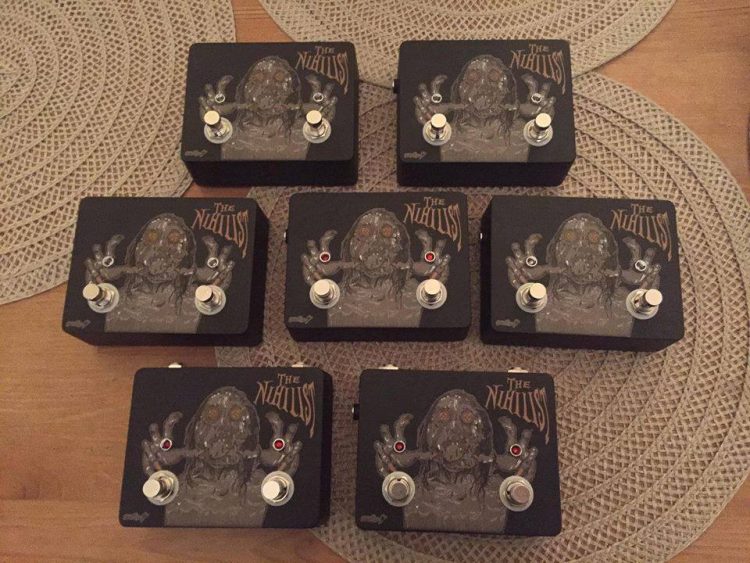
A batch of Nihilist pedals — Credit: Dunwich Amps
Kurt Ballou: One of the clones which bands I record really seem to like is an odd-ball Dunwich “Lady Baphomet” Nick made me that has pots to control frequency and bandwidth of each EQ band. Using pink noise and a spectrum analyzer, I can dial in the EQ to closely match the original, although the clone is a little fuller and louder. I guess that’s where the idea for the Nihilist came from. I didn’t want to calibrate a 10 knob pedal with an analyzer, and the only sound I want out of an HM-2 is everything on 10 (except the distortion) anyway, so why not just get the circuit dialed, then lock down all the values. Seems to do the trick. Even Uffe from Entombed is using one now!
Joe Anastasio: I just sent Scott Hull of Pig Destroyer / Agoraphobic Nosebleed a deluxe [Left Hand Wrath]. Also just sent A set of pedals out to Vallenfyre. The most iconic players using them right now would have to be Bloodbath. Me and Anders have something really awesome in the works.
My friends in Gatecreeper use Deluxe Left Hand Wraths. I’ve become good friends with Fred Estby from Dismember , we just did the first ever authorized Dismember lhw deluxe which is currently being assembled. Ryan Bram of Homewrecker studios has been using it since day one. Kurt Ballou has a stock model and a special deluxe model in the studio at Godcity. I’m sending some out to Jocke from Wolfbrigade shortly. Leon Sandow from Nails has been a long time user.
Nicholas Williams: Kurt put me in touch with Todd Jones (Nails) who bought a modded HM-2. Flash forward a year or so and Todd contact me regarding a custom HM-2 design that would become the Tyrant (Nails signature HM-2). After building an initial 4 units, I built 30 units that Nails sold shortly through their merchandise website after the release of “You Will Never Be One of Us”. Kurt also connected me with Brian Izzi (Trap Them) who commissioned a few 1 and 2knob custom HM-2s builds. One of those designs might be released in the future with Trap Them as a signature model. Victor Brandt (Entombed/Entombed A.D.) messaged me through my Dunwich Amps Facebook page. He ended up buying a modded HM-2 that was geared for bass use (shifted the EQ center-points down in frequency).
Patrick: I think Jay’s guitar tracks for Harm’s Way’s RUST do it great justice – it showcases the sound perfectly. Also a band from MN called Wanderer has used it to perfection, they are worth checking out for sure.
Jay Jancetic: I asked Patrick to make me a modified HM-2 clone with more mid and low end control. The result was so awesome, he decided to put it into production shortly after that, hence the Throne Torcher was officially born. I still have and use the original prototype on my pedalboard as my primary overdrive with my OG, block letter 5150 and a bunch of other goodies, including a custom boost Patrick also made for me.
Joe Anastasio: The entirety of Bloodbath’s “Grand Morbid Funeral” and Gatecreeper’s “Sonoran Deprivation” are probably the best instances of the Left Hand Wrath. Big fan of both of those albums and stoked for Gatecreeper getting so much exposure lately. It’s also on the new Vallenfyre LP which everyone should go get immediately.
Anders Nyström: We’ve been using both the LHW and HM-2 depending on the different circumstances that may occur between live and studio work. Once the Bloodbath limited edition model of the LHW comes out that’ll be the only pedal we’re gonna use.

Official Bloodbath LHW — Credit: Lone Wolf Audio
Antti Boman: I realized a year ago that I could bring some of it in my sound, and avoid the problems, so now [an HM-2 has] been there, at least on the gigs inside Finland.
David Pruitt [Guitarist for Petrification]: I heard about [the Left Hand Wrath] a few years ago after Joe had left a previous pedal company to start Lone Wolf Audio. I needed the heaviest pedal I could find to slam directly into my Furman PQ-3. The LHW was the top of that list and easily surpassed every other HM-2 I had tried, including original Japanese models. It’s built like a tank and LWA’s build-quality is unsurpassed. The added features of the LHW, such as decoupled mids knob, added presence knob and the “modern” switch allow complete control over each individual parameter and that helped me shape the sound that I needed for Petrification. The only other pedal I would consider right now is the Left Hand Wrath Deluxe.
Kurt Ballou: One thing I’ve learned from recording music is that sometimes, smaller is bigger. Not that an HM-2 sounds small, but the focused, limited frequencies not only have a ton of character, but open up the sound field for other elements to have their own space.
Rogga Johansson: It’s a legend, it’s the source of the sound for an entire part of the death metal scene. Even though I think there are too many bands just going for that exact sound these days, you can’t deny that music would be so much less cool sounding if it wasn’t around. I love the sound myself, and I think most people do when they hear it [on] a classic well-played and well-recorded album.
Tomas Skogsberg [when asked how he feels about the current trend of copping the Sweddeath sound]: Ha ha! It’s ok for me. I’m happy to be one of the creators.

Photo Credit: Steve Hinksman
Author’s Note: This article couldn’t have been possible without the immense patience and help from all the interviewees; thanks especially to Kurt Ballou who was extremely generous with his time and dealing with my persistent requests.
Abominable Electronics Facebook

